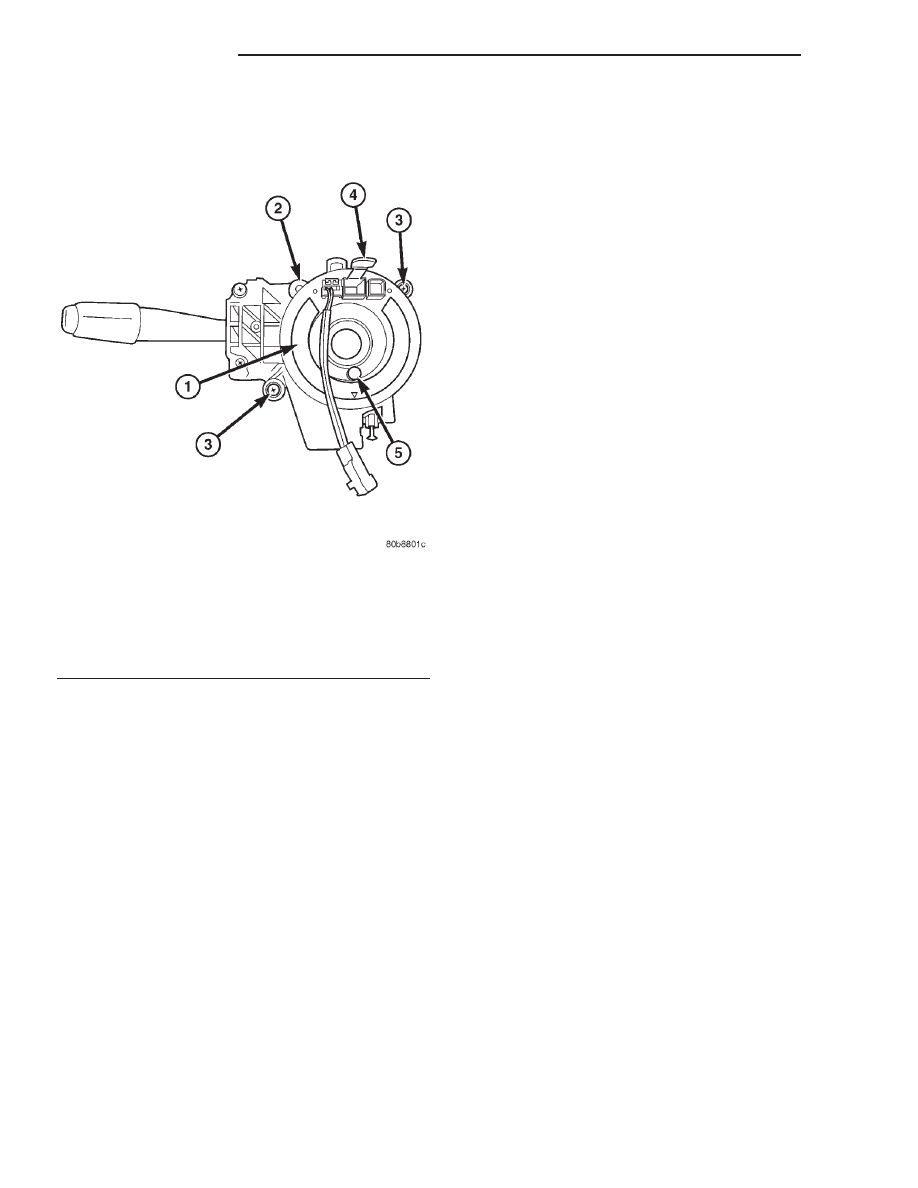Dodge Dakota (R1). Manual - part 348

CLOCKSPRING
DESCRIPTION
The clockspring assembly is secured with two
screws onto the multi-function switch mounting
housing near the top of the steering column behind
the steering wheel (Fig. 7). The clockspring consists
of a flat, round molded plastic case with a stubby tail
that hangs below the steering column and contains
two connector receptacles that face toward the
instrument panel. Within the plastic housing is a
spool-like molded plastic rotor with a large exposed
hub. The upper surface of the rotor hub has a large
center hole, two large flats, an engagement dowel
with a yellow rubber boot, a short pigtail wire with
connector, and two connector receptacles that face
toward the steering wheel. The lower surface of the
rotor hub has a molded plastic turn signal cancel
cam with two lobes that is keyed to the rotor and is
secured there with four integral snap features.
Within the plastic case and wound around the rotor
spool is a long ribbon-like tape that consists of sev-
eral thin copper wire leads sandwiched between two
thin plastic membranes. The outer end of the tape
terminates at the connector receptacles that face the
instrument panel, while the inner end of the tape
terminates at the pigtail wire and connector recepta-
cles on the hub of the clockspring rotor that face the
steering wheel.
Service replacement clocksprings are shipped pre-
centered and with a locking pin that snaps into a
receptacle on the rotor and is engaged between two
tabs on the upper surface of the rotor case. The lock-
ing pin secures the centered clockspring rotor to the
clockspring case during shipment, but the locking pin
must be removed from the clockspring after it is
installed on the steering column. (Refer to 8 - ELEC-
TRICAL/RESTRAINTS/CLOCKSPRING
-
STAN-
DARD
PROCEDURE
-
CLOCKSPRING
CENTERING).
The clockspring cannot be repaired. If the clock-
spring is faulty, damaged, or if the driver airbag has
been deployed, the clockspring must be replaced.
OPERATION
The clockspring is a mechanical electrical circuit
component that is used to provide continuous electri-
cal continuity between the fixed instrument panel
wire harness and the electrical components mounted
on or in the rotating steering wheel. On this model
the rotating electrical components include the driver
airbag, the horn switch, the speed control switches,
and the remote radio switches if the vehicle is so
equipped. The clockspring case is positioned and
secured to the multi-function switch mounting hous-
ing near the top of the steering column. The connec-
tor receptacles on the tail of the fixed clockspring
case connect the clockspring to the vehicle electrical
system through two take outs with connectors from
the instrument panel wire harness. The clockspring
rotor is movable and is keyed by an engagement
dowel that is molded onto the rotor hub between two
fins that are cast into the lower surface of the steer-
ing wheel armature. A yellow rubber boot is installed
over the engagement dowel to eliminate noise. The
two lobes on the turn signal cancel cam on the lower
surface of the clockspring rotor hub contact a turn
signal cancel actuator of the multi-function switch to
provide automatic turn signal cancellation. The yel-
low sleeved pigtail wires on the upper surface of the
clockspring rotor connect the clockspring to the
driver airbag, while a steering wheel wire harness
connects the two connector receptacles on the upper
surface of the clockspring rotor to the horn switch
and, if the vehicle is so equipped, to the optional
speed control and remote radio switches on the steer-
ing wheel.
Like the clockspring in a timepiece, the clockspring
tape has travel limits and can be damaged by being
wound too tightly during full stop-to-stop steering
wheel rotation. To prevent this from occurring, the
clockspring is centered when it is installed on the
Fig. 7 Clockspring and Multi-Function Switch
1 - CLOCKSPRING
2 - LOCATING PIN
3 - SCREW (2)
4 - LOCKING PIN
5 - ENGAGEMENT DOWEL AND BOOT
8O - 10
RESTRAINTS
AN